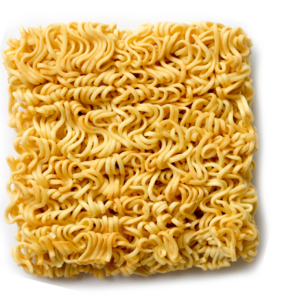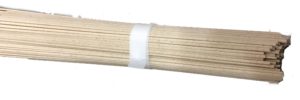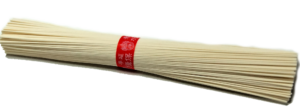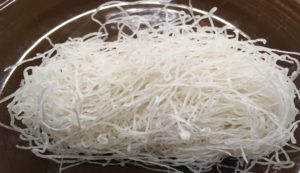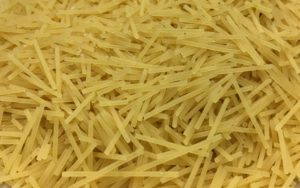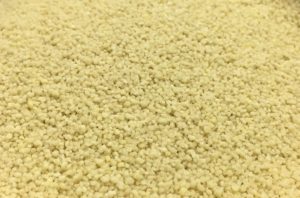Pasta and noodles are often used interchangeably to describe two basic types of shaped dough cooked in water. They are not the same, though. The difference between the two is their ingredients and origin. Here we break out the differences and discuss which types soften the quickest in hot and cold water.
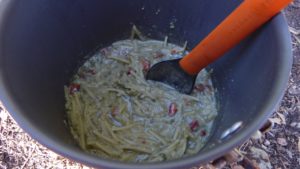
The Difference Between Pasta and Noodles
This simple mixing of grain flour and water into a dough has given us pasta, one of the most popular foods in the world. Italy and China are the two cultures that have explored all the possibilities of this food, resulting in two distinct preparations.
Pasta generally refers to Italian varieties of dough made from a hard durum semolina wheat with a firm texture. Pasta is essentially an uncooked dough made from only wheat and water. It is rarely parboiled, baked or fried before packaging. The dough is merely shaped and then dried for storage and packaging.
- Pasta from a store is seldom precooked and should be soaked in boiling water before eating. The thinner and smaller shapes will soften the fastest.
Noodles are a broad term used to describe pasta originating from Asian countries or containing ingredients other than wheat. Unlike pasta, noodles involve additional processing. For instance, Asian wheat-based noodles generally include added salt to help bind the dough and are then precooked, baked, or deep-fried before packaging. Ramen is a fried noodle block that can be eaten straight from the package, like a cracker. American/European noodles are not pre-cooked like the Asian varieties and often contain egg solids in addition to hard wheat.
Many Asian noodles contain no wheat, such as vermicelli noodles made from rice and cellophane noodles made from sweet potato or mung bean starch. If the noodles contain wheat, it’s a soft variety of wheat that cooks fast.
- Asian style thin noodles made out of pure starch – usually from mung bean, rice, or sweet potato – are intended to be ready to eat after soaking a few minutes in hot liquid. You can also eat these noodles cold, without using a stove. Starch noodles are made by boiling the noodles to gelate the starches, so they’re essentially pre-cooked. Soak in cold water for 20 – 25 minutes.
Eating Pasta without Cooking (i.e., soaking pasta in cold water)
When pasta is soaked only in cold water, it tastes like a floury wetted grain. The reason behind this is because cooking pasta is a two-stage process: hydration and heating. For the pasta to thoroughly absorb water, swell, and become edible, the starch present in the grain must hydrate in water and gelatinize via heat. When the water gets hot enough, the energy of its molecules swells as it disrupts the granules and leaks starch chains into the water. This process is called the gelation range.
Gelatinization of most grains occurs between 140° to 180°F (60° to 82°C) depending on the starch (amylose) content and thickness.[1] If you soak pasta below that temperature, a small portion of the starch from the grain will separate, but the pasta will remain mostly unchanged. You’ll be left with gritty pasta sinking in a floury paste. In other words, soaking uncooked pasta in cold water will not only taste bad but will be much harder to digest. Cooking destroys most of the anti-nutrients found in grains. In the case of wheat, these include lectins and phytates. Food safety is another reason to cook food because heat kills pathogens.
The only pasta type we recommend for cold soaking on the trail is one that has been pregelatinized (instant or precooked) and dried — commonly couscous, ramen, or any “instant” pasta. When eating cold soaked pasta be sure to keep it away from any potential sources of contamination and use treated water to soak it.
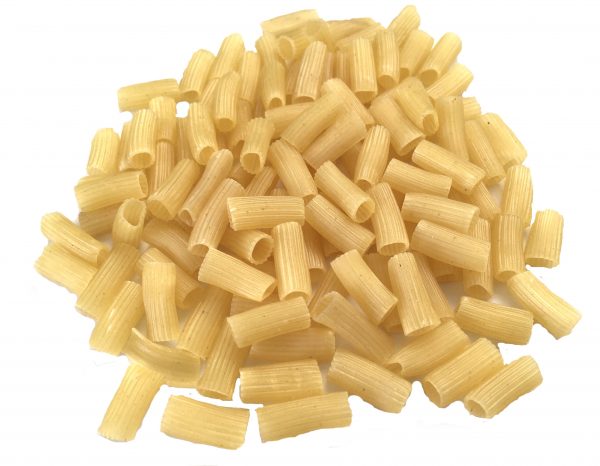
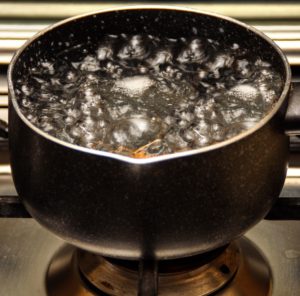
Non instant Pasta? Keep in mind that you don’t need to boil pasta, only the water
Pasta does not require a sustained boil to soften. If pasta is on your trail menu, drop the pasta meal in as soon as the water boils and cover it. Shut the fuel off and allow the pasta to soften in hot water for the instructed boil time. You’ll have a perfect al dente pasta without keeping the burner on and wasting stove fuel. This works because all starches absorb water at a maximum temperature of 180°F (82°C).As long as the water is at a rolling boil when you add the pasta, and you keep the pot covered, the water will remain at or above the gelation temperature for the typical 8 to 10 minutes it takes for the pasta to cook.
- An alternative is to soak the pasta in cold water first and then heat it to 180°F (82°C).
- In high elevations, water boils at a lower temperature. Add a few minutes to the soaking time. Use an insulated cozy to maintain the heat.
- If you need an arm workout while resting your legs, another method is to vigorously stir or shake your pasta meal. The mechanical action will help break the starch granules down and “cook” your pasta.
Types of Pasta and Noodles that are Good for Backpacking
It is not always easy to identify noodles that will rehydrate the quickest in hot water. One way is to read the label and look for the addition of these key ingredients: Potato starch, Polyphosphate, and Guar Gum. These compounds all improve the rate at which water absorbs in the noodles, and thus shorten the rehydration or cook time. Here’s a list of packaged pasta types that rehydrate the quickest in water –
Ramen noodles are instant curly noodles in a block form that is precooked and fried, baked or dried. Ramen is synonymous with a poor diet. See our tip below on making ramen healthier. No cooking or hot soaking is required – you can safely eat the block of ramen directly.
- Hot soak time: optional, or 3 – 5 minutes.
- Cold soak time: optional, or 8 – 10 minutes.

Soba noodles are a thin and long Japanese noodle made from a blend of wheat and buckwheat. Correspondingly, the buckwheat gives them a nutty and earthy flavor. Dried soba looks like angel hair spaghetti but is light brown in color. Don’t confuse with yakisoba, meaning “fried buckwheat,” which is a Japanese noodle similar to Soba that is intended for stir-frying. Unlike soba, yaki has added salt, egg, or yellow food dye.
Somen noodles are thin Japanese noodle made from wheat. They work just as well as soba noodles but do not contain buckwheat. Somen is a great alternative if you don’t like the earthy taste of buckwheat. Do not confuse somen noodles with udon noodles. Udon noodles are wider and thicker and do not work well for hot soak rehydration.
- Hot soak time: 6 – 8 minutes.
- Cold soak time: not recommended.
photo by Kropsoq
Vermicelli rice noodles are long, thin translucent thread-looking noodles made from rice with a texture similar to angel hair pasta. Instant vermicelli absorbs cold water the quickest. Do not confuse rice vermicelli with the thick and wide flattened rice noodles which are common in dishes such as pad thai. Flat rice noodles are not suitable for hot soaking.
Cellophane noodles are dried lightweight noodles made from pure starch, usually mung bean, rice, or sweet potato. They look like thin threads and are translucent to glossy in color. Cellophane noodles are typically sold in folded bundles in a cellophane-wrapped package. They are nearly instant, making them perfect for hot soaking.
- Hot soak time: 6 – 8 minutes.
- Cold soak time: 20 – 25 minutes.
Angel Hair pasta or capellini is thin and long strands of hard wheat pasta. Good for hot soaking.
Fideo pasta is short pieces of angel hair wheat pasta, about 2” in length. It can be found in the Mexican grocery section, or you can break angel hair pasta in pieces.
Instant Pasta
We can’t speak for all instant pasta, although the one we have at Outdoor Herbivore is fully cooked and dried to provide ultra-speedy rehydration. It works perfectly for pouch-style cooking or reheating in a thermos. This pasta contains absolutely no additives. It’s simply pasta made from organic U.S grown wheat.
- Hot soak time: 7 – 8 minutes.
- Cold soak time: 15 minutes
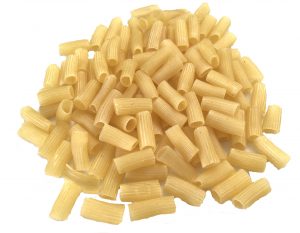 Couscous is a type of pasta made from crushed wheat. Get the North African or Moroccan couscous, which looks like yellow cornmeal and has been steamed and dried to allow for instant cooking. The large pasta pearls, sometimes called “Israeli” couscous, are not suitable for hot soaking.
Couscous is a type of pasta made from crushed wheat. Get the North African or Moroccan couscous, which looks like yellow cornmeal and has been steamed and dried to allow for instant cooking. The large pasta pearls, sometimes called “Israeli” couscous, are not suitable for hot soaking.
Gluten Free pasta – any thin shape of gluten-free pasta made with the primary ingredient of quinoa, corn or white rice typically works the best for hot soak cooking. Edison Grainery is a brand we love and use in our GF Chickpea Sesame Penne.
- Hot soak time: varies based on starch type.
- Cold soak time: varies based on starch type.
Making Ramen Noodles Healthier
While there are better choices of noodles besides ramen, the fried version is the noodle you’ll find stocked in trail-side gas stations and food markets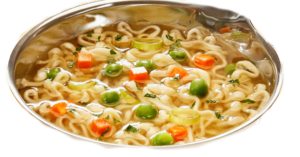 . Fried noodles might be convenient, cheap, and tasty, but it’s not the best for fueling your body with daily nutritional needs. The instant noodles are relatively high in calories and sodium but quite low in protein, fiber, vitamins, and minerals.[2] Fill the gap by adding freeze-dried mixed vegetables to these noodles. Keep in mind that Ramen also contains a lot of controversial preservatives. Typical additives include Tertiary-butyl hydroquinone (TBHQ) to prevent fat oxidation after deep frying, monosodium L-glutamate (MSG) to enhance the taste, and propylene glycol to retain moisture. Consider tossing aside the flavor packet which contains mostly sodium and more of these questionable ingredients.
. Fried noodles might be convenient, cheap, and tasty, but it’s not the best for fueling your body with daily nutritional needs. The instant noodles are relatively high in calories and sodium but quite low in protein, fiber, vitamins, and minerals.[2] Fill the gap by adding freeze-dried mixed vegetables to these noodles. Keep in mind that Ramen also contains a lot of controversial preservatives. Typical additives include Tertiary-butyl hydroquinone (TBHQ) to prevent fat oxidation after deep frying, monosodium L-glutamate (MSG) to enhance the taste, and propylene glycol to retain moisture. Consider tossing aside the flavor packet which contains mostly sodium and more of these questionable ingredients.
Lastly, many fried ramen brands use irresponsibly sourced palm oil which is directly responsible for the destruction of rainforests, animal habitat, and the abuse of humans. There are healthier options for Ramen which include those that are baked rather than fried in palm oil, and contain less sodium. Some brands that make healthier versions include Dr. McDougall’s, Koyo and Lotus Foods.
Related Posts:
References
[1] How gelatinization, retrogradation affect cooked cereals. (2016). Wattagnet.com. Retrieved 28 February 2019, from https://www.wattagnet.com/articles/27258-how-gelatinization-retrogradation-affect-cooked-cereals
Eats, S. (2019). Can I Start Pasta In Cold Water? | Ask The Food Lab. Seriouseats.com. Retrieved 28 February 2019, from https://www.seriouseats.com/2013/05/ask-the-food-lab-can-i-start-pasta-in-cold-water.html
[2] Gulia N, e. (2019). Instant noodles: processing, quality, and nutritional aspects. – PubMed – NCBI. Ncbi.nlm.nih.gov. Retrieved 1 March 2019, from https://www.ncbi.nlm.nih.gov/pubmed/24564594
Instant noodle. (2015). En.wikipedia.org. Retrieved 1 March 2019, from https://en.wikipedia.org/wiki/Instant_nood
WWF Palm Oil Buyers Scorecard – Measuring the sustainability of palm oil buyers. (2019). Palmoilscorecard.panda.org. Retrieved 1 March 2019, from http://palmoilscorecard.panda.org/
